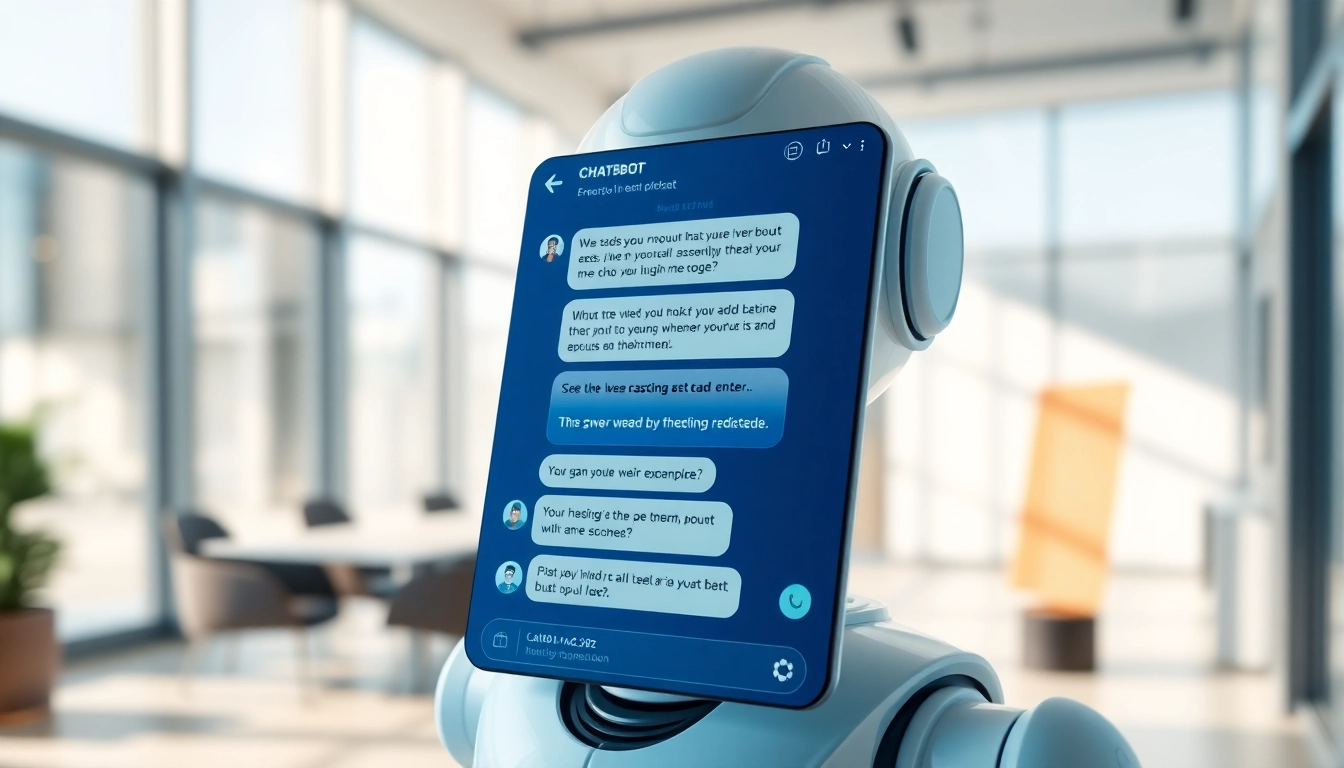Understanding Chatbots for Your Website
What is a Chatbot?
A chatbot is an automated software tool designed to engage in conversation with users, simulating human interaction. Utilizing artificial intelligence (AI), natural language processing (NLP), and machine learning, chatbots can understand, interpret, and respond to user queries in real time. They can be deployed on various platforms, including websites, messaging apps, and social media, making them a versatile tool for enhancing customer experience. By integrating a chatbot for website functionality, businesses can streamline their communication processes and provide immediate assistance to visitors.
Benefits of Using Chatbots
The advantages of integrating chatbots into your website are multifaceted, spanning customer service, marketing, and operational efficiency. Some of the significant benefits include:
- 24/7 Availability: Unlike human agents, chatbots operate round the clock, ensuring assistance is available at any time, which is particularly crucial for businesses with a global customer base.
- Cost-Effective: By employing chatbots, businesses can reduce operational costs associated with hiring and training staff for customer service roles.
- Instant Response: Chatbots can provide instantaneous answers to frequently asked questions, enhancing user satisfaction and engagement.
- Handling Volume: They can manage multiple inquiries simultaneously, handling increased traffic without compromising response quality.
- Data Collection: Chatbots can gather and analyze user data, providing insights into customer preferences and behavior, which can inform business strategies.
Types of Chatbots
There are primarily two types of chatbots that businesses can consider:
- Rule-Based Chatbots: These bots operate on pre-defined rules and scripts, providing responses based on specific user commands. They are simple to implement and can effectively handle straightforward queries but may struggle with complex interactions.
- AI-Powered Chatbots: Utilizing advanced algorithms, these chatbots can learn from interactions, enabling them to handle a wider range of inquiries and provide more natural, contextual responses. They are better suited for customer service tasks that require adaptability.
Implementing a Chatbot on Your Website
Choosing the Right Chatbot Tool
The first step in integrating a chatbot into your website is choosing the right tool. Ideally, select a chatbot platform that aligns with your business goals and technical capabilities. Consider factors such as:
- Functionality: Different platforms offer varied features, such as analytics, multilingual support, and integration capabilities. Assess which features are essential for your business.
- User-Friendliness: A tool that is easy to set up and manage can save time and reduce reliance on technical staff.
- Scalability: As your business grows, your chatbot needs may evolve. Ensure the chosen tool can scale accordingly.
- Cost: Analyze various pricing plans and determine the best return on investment based on your budget.
Setting Up a Chatbot
Once you have selected a chatbot tool, setting it up involves several key steps:
- Define Objectives: Clearly outline what you want the chatbot to achieve, such as answering FAQs, generating leads, or processing orders.
- Design Conversation Flow: Map out potential user interactions and design a natural flow for the conversation, ensuring that it aligns with user expectations and preferences.
- Customize Responses: Develop responses that reflect your brand’s voice and tone, making it easier for users to connect and communicate with the chatbot.
- Test the Chatbot: Before launching, conduct extensive testing to identify any issues and ensure that the chatbot handles various scenarios effectively.
Integrating with Existing Systems
To maximize the effectiveness of your chatbot, integration with existing systems such as Customer Relationship Management (CRM) tools, databases, and ecommerce platforms is essential. This ensures seamless data flow and enhances the chatbot’s capabilities. Key integration points include:
- CRM Integration: Allows the chatbot to access customer profiles, enabling personalized interactions.
- E-commerce Platforms: Facilitates order tracking, product recommendations, and sales transactions directly through the chatbot.
- Analytics Tools: Integrating with analytics tools can help monitor performance metrics and user engagement levels.
Best Practices for Chatbot Interactions
Creating Engaging Conversations
Engagement is crucial for user satisfaction. To create engaging conversations, consider the following best practices:
- Use Simple Language: Ensure that the chatbot communicates in clear, straightforward language that users can easily understand.
- Incorporate Humor: When appropriate, a touch of humor can make interactions more enjoyable, but ensure it aligns with your brand identity.
- Encourage Feedback: Soliciting user feedback can enhance engagement and provide valuable opinions on chatbot performance.
Personalizing User Experience
Personalization can significantly enhance user experience. Methods to personalize interactions include:
- Using User Data: The chatbot can leverage data such as previous interactions and customer preferences to tailor responses.
- Dynamic Responses: Customize the chatbot’s responses based on the user’s input or behavior on the site.
- Segmenting Users: Create different conversation paths depending on user segments, catering to diverse needs and expectations.
Measuring Chatbot Performance
To ensure the chatbot is meeting its objectives, it’s vital to measure its performance. Key metrics include:
- Response Accuracy: Assess how accurately the chatbot answers user questions. This can help identify knowledge gaps that need to be addressed.
- User Satisfaction Scores: Collect user feedback post-interaction to gauge satisfaction levels and identify areas for improvement.
- Engagement Metrics: Monitor the number of interactions, conversation duration, and repeat usage to understand user engagement with the chatbot.
Common Challenges and Solutions
Overcoming User Frustration
Users may experience frustration when interacting with chatbots, particularly if their inquiries are not resolved efficiently. To mitigate this, consider the following strategies:
- Escalation Protocols: Implement a smooth transition to human agents when the chatbot cannot resolve an issue, ensuring that users do not feel abandoned.
- Improve Context Understanding: Invest in AI training to enhance the chatbot’s ability to understand context and provide relevant responses.
Data Privacy Concerns
With increasing regulations around data privacy, addressing user concerns is crucial. Implement these best practices to safeguard data:
- Clear Privacy Policies: Communicate how user data will be collected, used, and stored.
- Data Encryption: Employ encryption to protect sensitive information exchanged during interactions.
Maintaining Chatbot Accuracy
Ensuring the chatbot provides accurate and relevant responses requires ongoing maintenance. Consider the following:
- Regular Updates: Conduct regular updates based on user feedback and changing business needs to keep the chatbot’s knowledge base current.
- A/B Testing: Experiment with different conversation flows and responses to identify which yields the best user satisfaction and engagement.
Future of Chatbots on Websites
Emerging Trends in Chatbot Technology
The chatbot landscape is constantly evolving, and businesses should stay ahead of emerging trends to leverage new opportunities. Some notable trends include:
- Natural Language Processing Enhancements: Continuous improvements in NLP will enable chatbots to understand and respond to complex queries more effectively.
- Voice-Enabled Chatbots: As voice technology becomes increasingly prevalent, integrating voice recognition features into chatbots is set to transform user interactions.
- Omnichannel Support: Future chatbots will offer seamless experiences across multiple channels, allowing users to switch from website chats to mobile apps without losing context.
Impact of AI on Chatbot Development
Advancements in AI technology are reshaping how chatbots are developed and deployed. Highlights of AI impact include:
- Enhanced Personalization: AI algorithms can analyze user behavior to create highly personalized interactions, thereby improving user experience.
- Emotion Recognition: AI can analyze user tone and sentiment, allowing chatbots to adjust their responses based on emotional context.
Expanding Uses Beyond Customer Service
While customer service remains a primary use case, chatbots are finding expanded applications across various domains. Some emerging uses include:
- Lead Generation: Chatbots can initiate conversations with potential customers, qualifying leads and guiding them through the sales funnel.
- Content Delivery: Chatbots can curate and deliver personalized content, enhancing user engagement with targeted articles, videos, and promotions.
- Feedback Gathering: Businesses can use chatbots to collect feedback on products and services, helping to inform strategic decisions.



